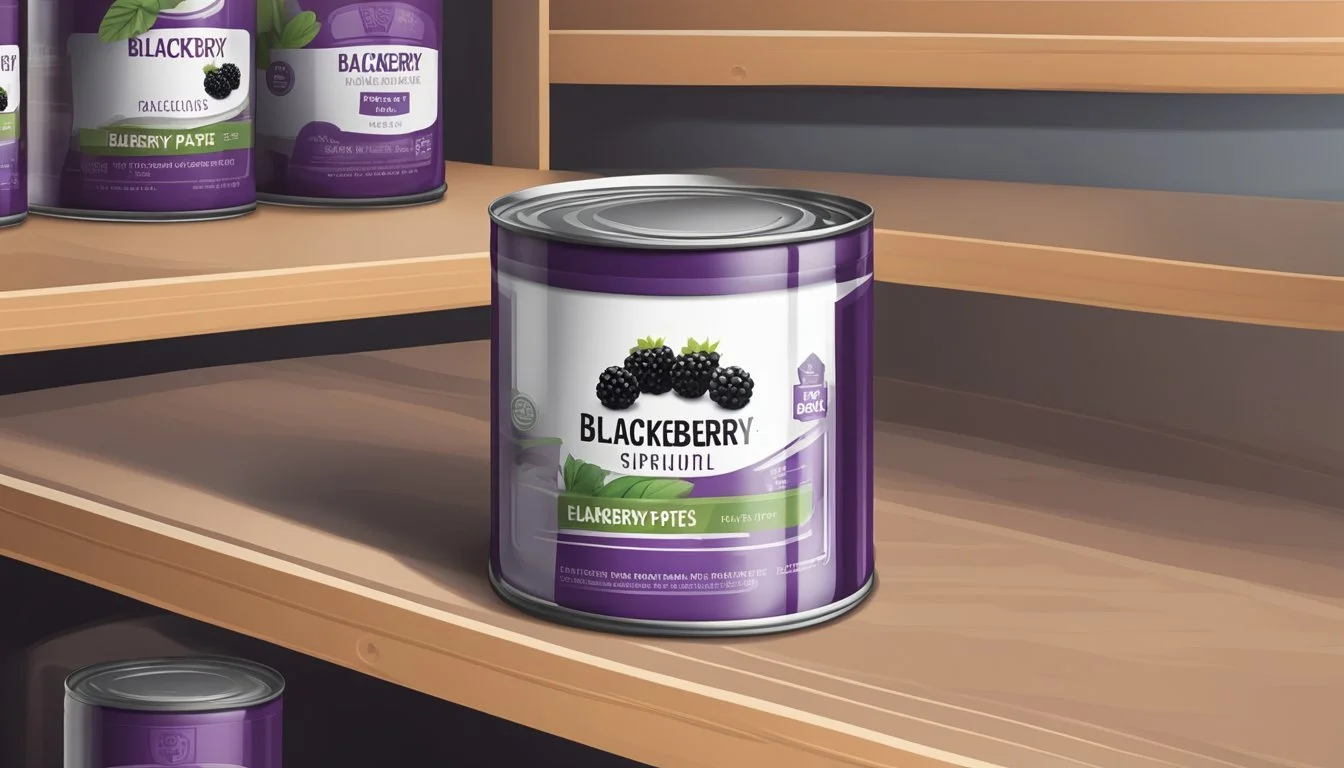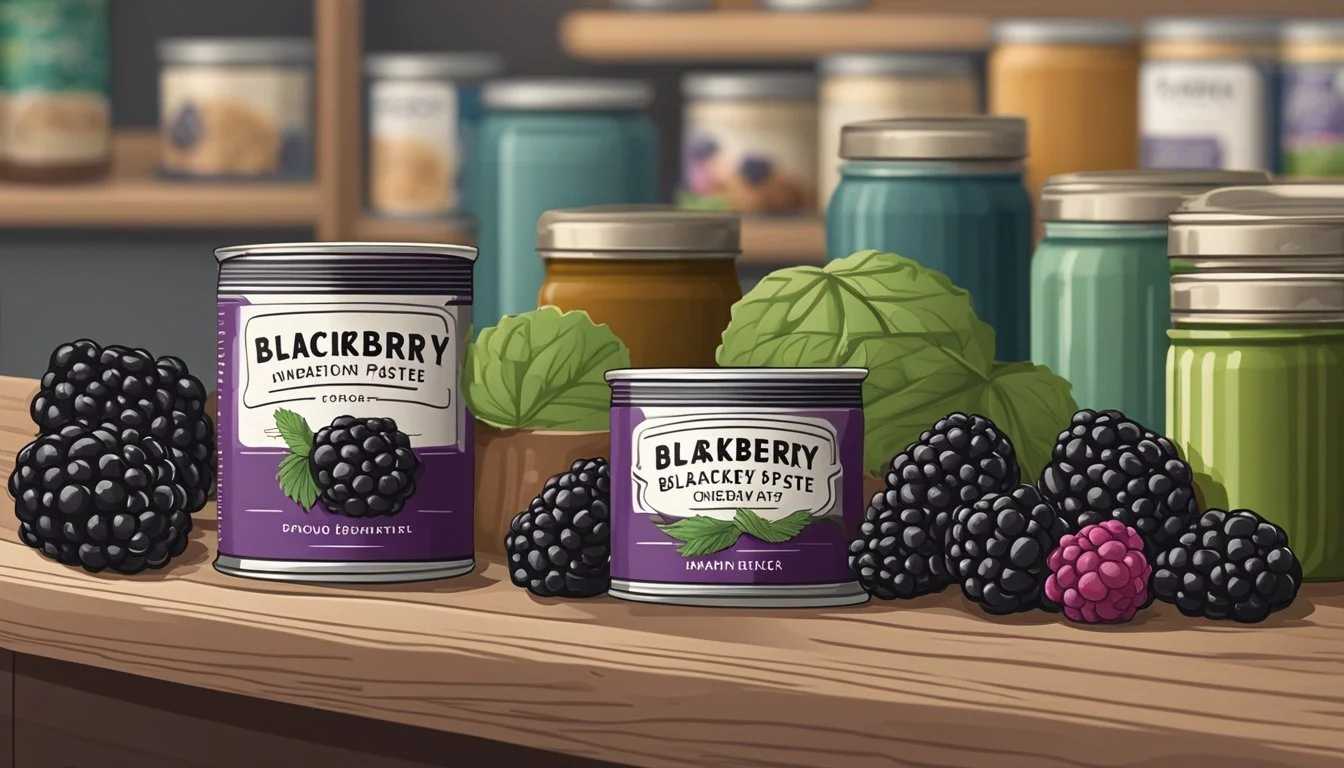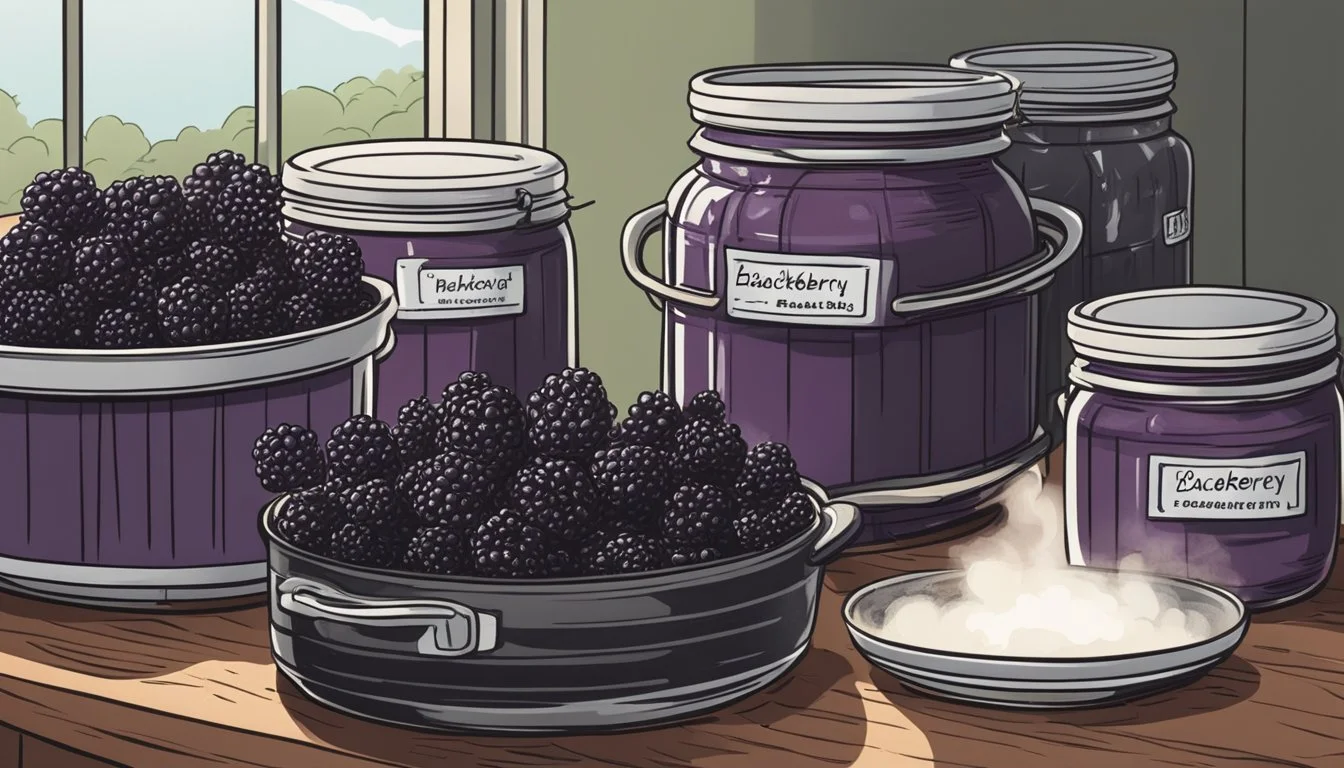How Long Does Canned Blackberry Paste Last?
Shelf Life and Storage Tips
Canned blackberry paste, like other home-canned goods, is subject to the constraints of shelf life, which can be influenced by various factors such as the canning method used, storage conditions, and the quality of the raw ingredients. The process of canning is a method of food preservation that extends the shelf life of perishable items by sealing them in airtight containers, thereby preventing the growth of microorganisms. When properly executed, this method ensures both the safety and longevity of the preserved food.
Shelf life is a key consideration for anyone involved in home canning or purchasing canned goods. For home-canned blackberry paste, the timeframe during which the highest quality is maintained typically spans about one year after canning. While the paste remains safe to consume beyond this period, particularly if properly pressure-canned and stored in a cool and dark environment, the quality in terms of flavor and texture may begin to deteriorate over time.
While safety is a paramount concern in food preservation, it's important to note that a sealed jar alone does not guarantee safety. One must ensure adherence to rigorous canning guidelines to minimize the risk of foodborne illnesses. Observing the integrity of the jar seal and the absence of visible spoilage are initial steps in verifying safety before consumption. Regular inspection and proper storage practices contribute to maximizing both the quality and safety of canned blackberry paste.
Understanding Canning and Food Preservation
In the realm of food storage, canning stands out as a reliable method to extend shelf life while maintaining food safety. This section delves into the key concepts and significance of canning as a method of food preservation.
Basics of Canning
Canning is a method of preserving food in which contents are processed and sealed in an airtight container. Home canning involves two main methods: using a water bath canner for high-acid foods like fruits, and using a pressure canner for low-acid foods to prevent botulism toxin contamination. The National Center for Home Food Preservation provides guidance on proper canning techniques to ensure safety and quality.
Water Bath Canner: Typically used for acidic foods (pH below 4.6)
Examples: Fruits, pickles, jams
Process: Jars are filled with product, sealed, and submerged in boiling water for a specified period.
Pressure Canner: Necessary for low-acid foods (pH above 4.6)
Examples: Vegetables, meats
Process: Jars are placed in pressurized steam, reaching higher temperatures than boiling water.
Importance of Food Preservation
The primary goal of food preservation is to inhibit the growth of bacteria, yeasts, or fungi, and to slow the oxidation of fats which cause rancidity. It allows for extending the shelf life of food, making it accessible beyond the harvest season. By following food safety guidelines during the canning process, risks such as contamination and botulism toxin are minimized, ensuring that food remains safe for consumption.
Food Safety: Adherence to recommended practices prevents contamination.
Example: Using sterilized equipment and following up-to-date recipes.
Shelf Life Extension: Properly canned food can last from one year to several years, depending on the product and storage conditions. However, best flavor and nutritional quality are typically maintained within the first year of storage.
Essential Storage Guidelines
To maintain the quality and extend the shelf life of canned blackberry paste, understanding and implementing effective storage measures are crucial.
Optimal Storage Conditions
Blackberry paste, when canned, is best preserved in a cool and dry place away from direct sunlight. The area should have a consistent temperature to avoid compromising the seal of the cans. The most ideal conditions for storage include:
Temperature: Between 50-70°F (10-21°C)
Humidity: Low to moderate
Light exposure: Minimal to none
Cabinets or pantries often offer these conditions, making them suitable choices for storage.
Impact of Temperature on Shelf Life
The shelf life of canned blackberry paste is significantly influenced by temperature fluctuations. Storage at temperatures outside the optimal range can lead to deterioration in quality and freshness. For longevity, one should note:
Above 75°F (24°C): The risk of the can's contents degrading faster increases, potentially affecting the taste and texture.
Below 50°F (10°C): While cooler temperatures can help maintain freshness longer, freezing temperatures can compromise the integrity of the can and its contents.
Maintaining a steady, moderate temperature is key for preserving the best qualities of canned blackberry paste over time.
Determining the Shelf Life of Canned Blackberry Paste
When assessing the shelf life of canned blackberry paste, two main factors to consider are the expiration date marked on the packaging and the integrity of the can's seal. These indicators will significantly influence how long the paste remains safe and maintains quality.
Identifying Expiration Dates
The shelf-life of unopened canned blackberry paste generally extends to 18-24 months under optimal storage conditions. Most cans will have a "best by" or "expiration date" printed on them, which consumers should check before use. It's important to store cans in a cool, dry place away from sunlight to preserve their shelf-life.
Signs of Spoilage
A can of blackberry paste that has not been compromised should remain vacuum-sealed, protecting the contents from spoilage. However, certain signs indicate spoilage:
Bulging or swelling: This can be a sign of bacterial growth and gas production inside the can.
Rusting or pitting: Compromised integrity of the can may lead to contamination.
Leaking: Any sign of liquid escaping from the can indicates a broken seal.
Odor: An off-smell upon opening can be a clear sign of spoilage.
If the canned blackberry paste shows any of these signs, it should not be consumed, as this indicates that the contents may not be safe to eat.
Maximizing Freshness and Quality
Maintaining the quality and taste of canned blackberry paste hinges on proper handling after opening and precautions to thwart oxidation and contamination. These measures are critical for keeping the paste as fresh as possible.
Handling Opened Cans
Once a can of blackberry paste is opened, it should be transferred to an airtight container if not used immediately. The remaining contents must be refrigerated to preserve freshness and prevent spoilage. To ensure the best quality, opened blackberry paste should preferably be consumed within 1 to 3 months.
Preventing Oxidation and Contamination
Preventing air exposure is key to maintaining the quality of blackberry paste. Cover the surface of the paste with a sheet of plastic wrap before sealing with a lid to minimize oxidation. Additionally, using clean utensils each time the paste is served can help prevent contamination. Ingredients and lids play significant roles in this, as high-quality ingredients and well-sealing lids contribute to the longevity of the paste.
Health and Safety Considerations
When storing canned blackberry paste, understanding health and safety measures is crucial. Contaminants can compromise the safety of canned goods, so strict adherence to safety guidelines ensures the well-being of consumers.
Potential Risks of Spoiled Canned Goods
Spoiled canned goods pose serious health risks to consumers. Botulism is a primary concern with improperly stored or contaminated canned foods, especially those that are low in acid. This rare but serious illness is caused by a toxin produced by the bacteria Clostridium botulinum. Signs that canned goods may have spoiled include bulging lids, leaking cans, an off odor, or any visible signs of deterioration.
Safety tip: Always inspect canned goods before use, discarding any with signs of spoilage.
USDA Recommendations for Canned Foods
The United States Department of Agriculture (USDA) offers guidelines to enhance the safety and longevity of home-canned goods.
High-acid foods, such as tomatoes and certain fruits, have a recommended shelf life of 12 to 18 months.
Low-acid foods, which include meats and vegetables, should be consumed within 2 to 5 years.
For home-canned blackberry paste, which is typically a high-acid food due to the natural acidity of the fruit, following USDA canning processes closely can ensure safe consumption.
Storage: Store cans in a cool, dark place and consume them within the recommended time frame.
Inspection: Before use, check for seals and lids that are intact and not showing signs of corrosion or damage.
By addressing these considerations and implementing the USDA's protocols, consumers can safely enjoy home-canned blackberry paste.
Practical Tips for Using Canned Blackberry Paste
Canned blackberry paste offers a versatile and rich addition to various recipes and can serve as a base for delightful treats. Its concentrated flavor ensures that each use, whether as a spread or ingredient, brings a burst of blackberry goodness to the dish.
Incorporating into Recipes
When using blackberry paste in recipes, one should think of it as a concentrated flavor enhancer. A tablespoon added into oatmeal not only infuses it with a robust blackberry taste but also adds a lovely color. Blackberry muffins benefit greatly from a dollop of this paste; it can be swirled into the batter before baking to create pockets of fruity flavor.
Blackberry Cobbler: Stir blackberry paste into the fruit filling, perhaps with a cinnamon stick for added warmth, to enrich the dessert's depth.
Homemade Jam: Augment the blackberry essence in a homemade jam by adding a small quantity of the paste to the saucepan as the jam cooks.
Simple utensils like a wooden spoon or a potato masher can be utilized to blend the paste smoothly into recipes, ensuring an even distribution without over-processing the other ingredients.
Alternative Uses
Blackberry paste's use extends beyond traditional pairings and baking recipes. It shines as a key ingredient in a myriad of alternative applications that require a strong fruit presence.
Sauces: Heat the paste gently in a saucepan to create a savory blackberry sauce for meats or a sweet topping for ice cream. A splash of lemon juice can be added to balance the sweetness.
Preserves Marker: For those who indulge in canning, blackberry paste can be used as a marker to indicate ideal consistency. When it falls off a spoon similar to your canned preserves, they are likely done.
Whether one is enhancing a breakfast classic or elevating a gourmet dish, a jar of canned blackberry paste can be a secret weapon in the pantry. Its concentrated berry flavor and rich texture make it ideal for a variety of culinary pursuits.
Exploring the Benefits beyond Storage
When considering the shelf life of canned blackberry paste, one should not overlook the additional advantages it offers, particularly in the realms of nutrition and the ease it brings to culinary practices.
Nutritional Aspects
Canned blackberry paste retains most of the essential nutrients found in fresh blackberries. Blackberries are a rich source of vitamins C and K, fiber, and antioxidants, which are largely preserved through the canning process. The paste can serve as a convenient nutritional supplement in diets, offering a good dose of these vitamins and antioxidants that can help support immune health and aid digestion.
Vitamins: Contains vitamins C and K, essential for immune function and bone health.
Fiber: Helpful in maintaining digestive health.
Antioxidants: Assist in neutralizing free radicals in the body.
Convenience and Versatility
The availability and ease of use of canned blackberry paste make it a versatile ingredient in the kitchen. It can be utilized in various recipes ranging from homemade blackberry juice to blackberry wine. Unlike fresh blackberries that need to be washed, canned blackberry paste is ready to use, which saves time and reduces food waste, as it does not spoil as rapidly as fresh berries.
Homemade Blackberry Juice & Wine: Easily blend canned paste with other ingredients.
Substitute for Grape Jelly: Can be used in recipes as a more nuanced alternative.
Alternative to Frozen Blackberries: Offers a longer shelf life without the need for freezing, making it a convenient option for off-season use.
Canning Blackberry Paste at Home
Canning blackberry paste at home is a rewarding way to preserve the fruit's flavor and enjoy it year-round. This section details the necessary equipment and steps required for creating a long-lasting preserve.
Required Equipment and Materials
Pressure canner: A necessity for canning blackberry paste to ensure safe preservation.
Canning jars: Preferred sizes are 2 one-pint jars or 4 half-pint jars. They must be sterilized before use.
Lids and rings: For sealing the canned blackberry paste.
Jar lifter and canning funnel: For safe handling and transferring paste into jars.
Potato masher: To mash the blackberries and release their juices.
Fine mesh strainer: For straining the fruit pulp.
Large pot: For simmering the berries and pectin.
Brandy (optional): Can be added for flavor enhancement.
Powdered pectin: Helps the blackberry paste achieve the desired consistency.
Step-by-Step Canning Process
Prepare Blackberries: Begin by washing the blackberries and removing any stems. Heat the berries in a large pot, gently mash, and then simmer for about 2 minutes.
Strain: Pass the simmered berries through a fine mesh strainer to separate the pulp.
Mix with Pectin: Return the fruit pulp to the pot, add powdered pectin, and follow the pectin package's instructions to ensure proper setting.
Sterilize Jars and Lids: While the paste cooks, sterilize the jars and lids in boiling water.
Fill Jars: Use a canning funnel to fill the jars with blackberry paste, leaving a 1/2-inch headspace.
Remove Air Bubbles: Slide a non-metallic utensil down the inside of the jars to remove any air pockets.
Seal Jars: Clean the jar rims with a damp towel, apply lids and screw rings until fingertip tight.
Process in Pressure Canner: Place jars in the pressure canner with water according to the manufacturer’s instructions and process for the time specified.
Cool Down: Allow jars to cool gradually once removed from the canner.
Store: Label jars with the date and store them in a cool, dark place.
By following these meticulous directions, canners ensure blackberry paste is preserved safely, retaining maximum quality and flavor when stored properly.
Conclusion
Canned blackberry paste, when prepared and preserved properly, has a significant shelf life. One can expect peak quality in the first year of storage. Despite the decrease in optimal flavor and texture after this period, the preserves remain safe to consume.
For the best results in preservation:
Jars should have 1/2 inch of headspace
Air bubbles are to be removed prior to sealing
Rims must be wiped clean for a good seal
During storage, conditions matter. It is crucial to store the canned blackberry paste in a cool, dry place, away from sunlight and significant temperature fluctuations. Regular inspection of jars is recommended to check for signs of spoilage such as:
Leaks
Off smells
Visible mold
In summary, one's careful attention to the canning process and storage conditions ensures the longevity and safety of home-canned blackberry paste. Consumers are encouraged to enjoy their preserves within the first year but can rest assured that the contents remain safe for consumption well beyond this period.









